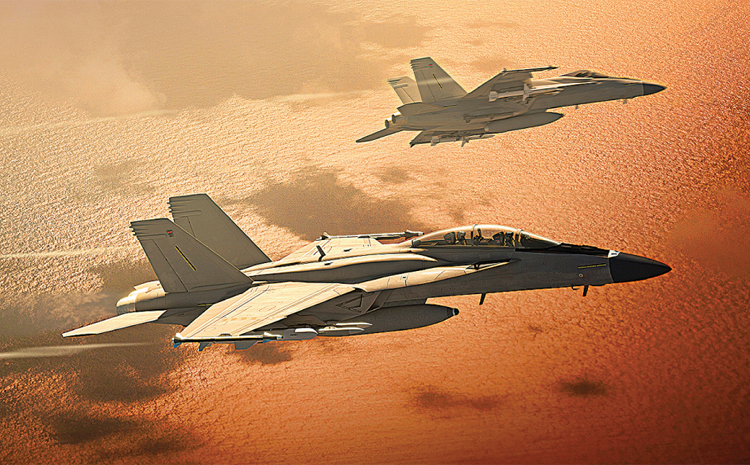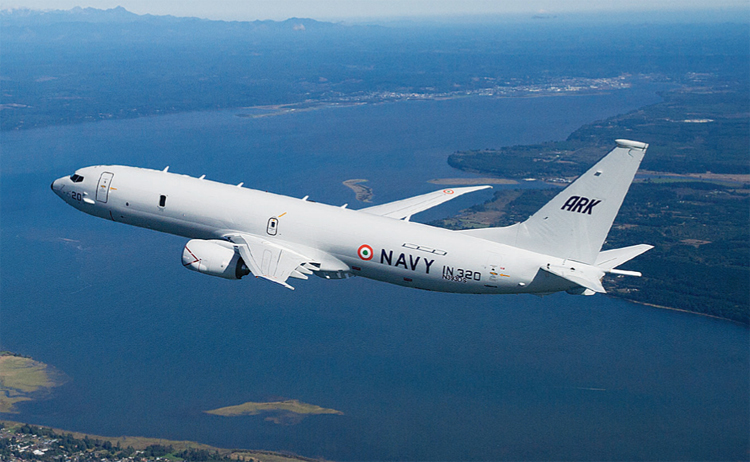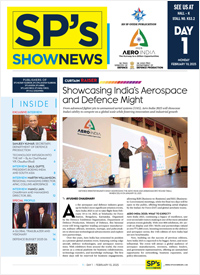- Prime Minister Narendra Modi inaugurates Aero India 2023 in Bengaluru; Releases Commemorative Stamp
- Defence Secretary meets delegations from Saudi Arabia, USA and Oman on the sidelines of Aero India 2023
- Foreign Ministers of 32 countries to attend Aero India 2023
- Embraer showcases the C-390 Millennium at Aero India 2023
INTERVIEW / BOEING
“Our vision is to bring the best of Boeing to India and export the best of India to the World”
In conversation with Michael Koch, Vice President, Boeing Defence, Space & Security, India

SP's ShowNews (SP’s): Boeing has strengthened its defence business in India with many of its iconic platforms servicing the Indian armed forces. How do you see the Indian market growing from your perspective?
Michael Koch (Koch): India’s defence sector is poised for growth and Boeing is committed to supporting and enabling this progress. Boeing has had a presence in the country for over 75 years now, and we’ve had many firsts with India. India was the first international customer for the P-8, is the largest international operator of C-17s and P-8s, and the Harpoon missile was the first US weapon system on an Indian-built fighter.
The future looks promising and we continue to see several opportunities in India. We’re engaged with our defence customers on their requirements for the Indian Air Force’s Multi-Role Fighter Aircraft and the Indian Navy’s Carrier-Borne Fighter programme. Early last year, the Ministry of Defence signed the contract for the acquisition of an additional six Apaches for the Indian Army.
Today, with 11 C-17s, nine P-8Is with three more on order, 22 AH-64 Apaches with six more on order with the Indian Army, and 15 CH-47 Chinooks, India is at the front and center of Boeing’s business plans.
We’re also seeing the growth in our localisation of MRO services and training, and the value Boeing Defence India, our local establishment in India, is able to provide through the lifecycle of Boeing products. We work with the Indian Air Force and the Indian Navy to provide exceptional operational capability and readiness to the P-8Is, C-17s, and Head of State aircraft through local sustainment services in India. Boeing is also providing pilot training for the Indian Air Force fleet of the C-17 aircraft; and we are in the process of providing training to Indian Navy pilots on the P-8I.
We’re contributing to the growth of India’s aerospace industry; that’s why we’re investing in partnerships across the ecosystem in skilling, research & technology, and manufacturing. India’s role in our global supply chain is big and getting bigger. Our commitment to India is deep and it’s for the long term; our vision is to bring the best of Boeing to India and export the best of India to the world.
SP’s: Boeing recently announced the results of the ski jump trials of the F/A-18 Block III Super Hornet. Are there any updates on your talks with Indian Navy for their fighter requirements?
Koch: Boeing and the US Navy recently proved that the F/A-18 Super Hornet can operate from a ski jump, thereby demonstrating the aircraft’s ability to operate on Indian Navy carriers.
We are engaging with the Indian Navy and have responded to the Request for Information for the Multi-role Carrier Borne Fighter (MRCBF) programme. This is a very exciting opportunity to partner with both the Indian Navy and the US Navy. The F/A-18 Super Hornet is the frontline carrier-based fighter of the US Navy, and will not only provide superior war fighting capability but also create opportunities for cooperation in naval security and aviation between the United States and India. The aircraft will be an incredible tool to ensure security and safety in the Indo Pacific region for decades to come.

SP’s: Why do you believe the Super Hornet will meet the Indian Navy’s requirements for a carrier borne fighter?
Koch: It is important to understand that apart from being the most lethal, advanced and combat-proven aircraft, there would be benefits from the incredible know-how and technology investments made by the US Navy related to aircraft carriers and fighter operations at sea. As a strategic partner for security, US Navy is leaning in to provide the best solution available for Indian Navy. This includes the F/A-18 Block III Super Hornet, but it also includes deep capabilities in sustainment, logistics, flight ops, carrier and network integration, etc. These machines are powerful on their own, but they are far more potent when they are part of a fully integrated network of capabilities.
The Super Hornet was designed for the carrier deck and benefits from decades of experience Boeing and US Navy had operating classic Hornets. The Indian Navy would receive the benefit of US Navy’s multi-billion dollar investments in Block III technologies, including advanced networks, longer-range detection with Infrared Search & Track, an all-new Advanced Cockpit System, improved signature reduction and a 10,000+ hour life. The F/A-18 Block III Super Hornet will be a game changer for the Indian Navy providing them several unique and differentiated capabilities.

Another important operationally relevant distinction is that the Super Hornet would prove a force multiplier for the Indian Navy through enhanced networked warfare with other US origin assets that the Indian Navy and the Indian Air Force have, or are in the process of acquiring. The F/A-18 Super Hornets can optimally interface with the P-8I, augmenting lethality of these platforms and enhancing India’s force projection capabilities.
As part of Boeing’s “for India, by India” philosophy, the Block III Super Hornets can be serviced in partnership with the Indian Navy, US Navy and industrial partners from India and the US throughout the lifecycle of the aircraft. This will further develop advanced expertise in aircraft MRO in India, resulting in higher availability of the aircraft at competitive pricing. All these together, with the fact that the Super Hornet is the most affordable tactical fighter in its class ‘per flight hour’ differentiates Boeing’s F/A-18 Block III Super Hornet offer for the Indian Navy.
SP’s: P-8I has always proven its capabilities and has been a strong pillar for Indian Navy when it comes to maritime security. There are three more to be delivered? Any update on the remaining P-8I delivery and your future plans for P-8I fleet?
Koch: In November, last year, Boeing delivered the ninth P-8I to the Indian Navy. This was the first of the four options aircraft, with the remaining three scheduled for delivery this year. The Indian Navy was the first and is the largest international customer for the P-8. This aircraft is an integral part of the Indian Navy’s fleet and is approaching an impressive milestone of 30,000 flight hours since induction in 2013.
Our focus has been, and will continue to be, delivering the world’s best maritime patrol aircraft to the Indian Navy. We’ve been supporting India’s growing P-8I fleet by providing spares, ground support equipment and field service support. Boeing’s logistics support has enabled the highest state of fleet-readiness at the best possible cost. Boeing is currently completing construction on a Training Support & Data Handling (TSDH) Centre at INS Rajali, Arakkonam, in Tamil Nadu, and a secondary centre at Naval Institute of Aeronautical Technology, Kochi, as part of a training and support package contract signed in 2019. The localised, ground-based training will allow the Indian Navy crew to increase mission proficiency in a shorter time, while reducing the on-aircraft training time resulting in increased aircraft availability for mission tasking.
The P-8I’s unmatched maritime surveillance and reconnaissance capabilities, versatility and operational readiness are uniquely qualified to perform India’s range of missions across the Indian Ocean Region, and thus the aircraft has proven to be an important asset to the Indian Navy. We do believe that the Navy has requirement for more P-8Is as also more Harpoons and we stand ready to support them.
SP’s: When can the Indian Army expect the Apache Helicopters?
Koch: The AH-64 Apache helicopters will be a force multiplier for the Indian Army, just as it is today for the Indian Air Force. The Indian Army AH-64E Apaches are planned to deliver in country 48-49 months after contract award. We are assessing any impacts due to Covid-19 and communicating regularly with the Indian Army.
Our Tata Boeing Aerospace Ltd (TBAL) joint venture in Hyderabad is a critical source of Apache manufacturing for the US Army and customers worldwide. Much of the contracted six Apaches for the Indian Army will be built at the state-of-the-art TBAL manufacturing facility right here in India.





